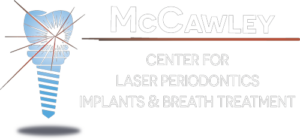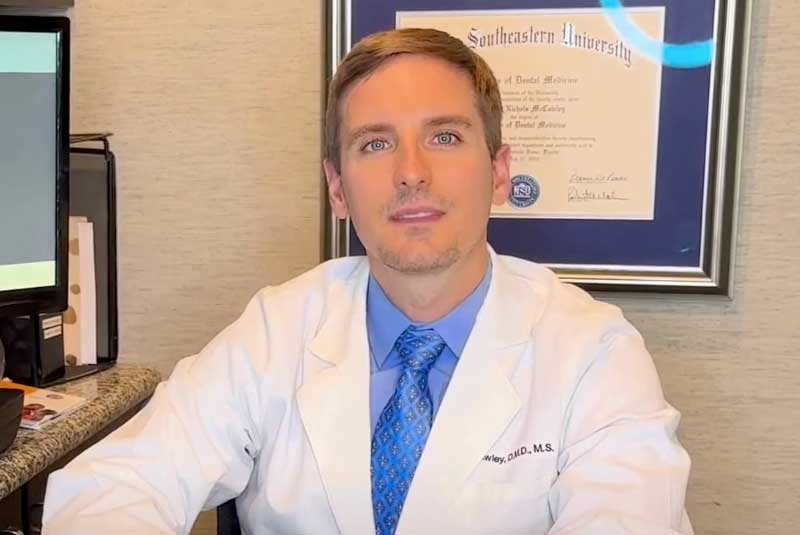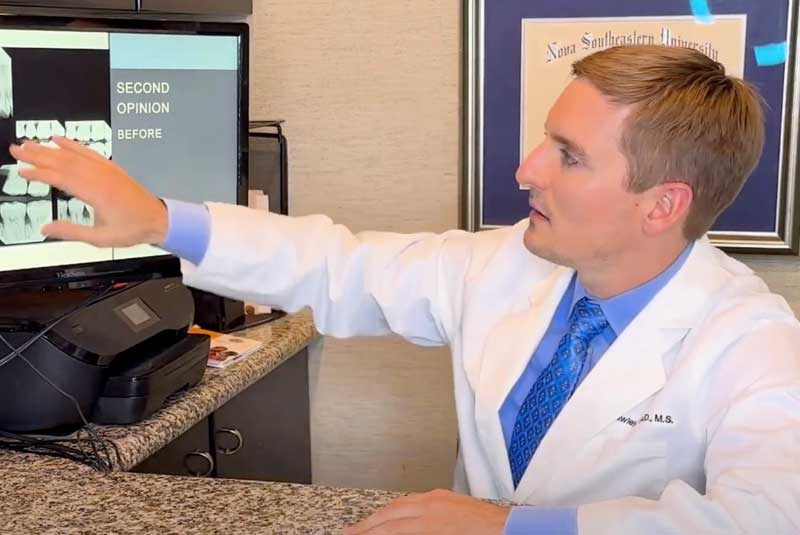
Yes, 2 implants can almost always be placed to stabilize a lower denture. In fact, 4 or more implants can be placed in the “all on 4” procedure to produce a solid bite often the same day for both upper and lower arches. You will be able to eat and chew normally again!
Remember that wearing dentures accelerates the bone loss of the jaw and results in the loss of support from your facial muscles causing you to look older more quickly. Implants can help stop this loss, restoring good chewing and give you a younger appearance.
Patients often wonder how to find the right laser periodontist to treat their periodontal disease. We suggest that you ask 5 key questions:
Nearly everyone has enough bone for an implant or enough bone can be created. It’s necessary to take a 3-D x-ray to visualize the bone in 3 dimensions to determine how much bone is present. In some cases additional bone grafting is necessary. Most implants that we place require no separate bone replacement procedure. In most cases it is a simple procedure to place the implant and 3-4 months later your dentist will place a crown on it and you regain complete function and chewing.
Do they allow almost an hour to first listen to my concerns and review my medical and dental history and then do a comprehensive oral examination? The following is a checklist of our examination:
The examination should include an oral cancer screening, an evaluation of bite forces that may aggravate gum problems, a joint and muscle assessment, an evaluation of pockets, recession, bleeding and pus and evaluation of how loose the teeth are. Tooth decay and defective crowns and filling should be noted.
Most importantly the causative bacteria should be evaluated on a phase contrast microscope for the presence of pathogenic bacteria and protozoa like amoeba. If indicated for more advanced disease, a bacterial culture should be taken and sent to a laboratory for analysis.
Radiographs will be taken and studied if not available from the referring office. If implants are needed a 3-D Scan will be taken to measure the available bone in three dimensions.
Finally do they review their findings and explain the recommended treatment in detail focusing on minimally invasive treatments using a laser for pockets and infection and Pinhole Surgery for receded gums?
There are 7 key questions we advise patients to ask when searching for a great periodontist.
Since gum disease affects almost 50% of the population, it is important to diagnose and treat the bacteria causing gum disease not only to save your teeth but also to save your life. These bacteria get in the bloodstream and increase the risk of many diseases.
Gum disease has been proven to substantially increase the risk of heart disease. A recent American Heart Association study found that it increases the risk of first heart attacks by 28 %.*
It also increases the risk of Alzheimer’s disease. The bacteria that cause gum disease have been found in the brain of 90% of Alzheimer’s patients.*
Gum disease has been found to increase the risk of several cancers including a 55% increased risk of pancreatic cancer. (See appendix)
In addition, the bacteria from gum disease have been found to increase the risk of diabetes and stroke making it very important to have gum disease treated to protect your overall health and well-being.
There are several signs that indicate gum disease.
Your dentist or periodontist can determine if you have gum disease by measuring the depth of the pockets around your teeth with an instrument called a periodontal probe. Measurements of 2-3mm are healthy, 4-5mm pockets indicate early to moderate disease, 6-8mm pockets indicate advanced disease and pockets 9mm or more indicate the tooth may not be savable.
It’s important to identify gum disease early before it becomes serious and treatment is difficult if not impossible. About 30 million people in the United States have lost their teeth mostly from periodontal disease and have dentures that cause poor chewing and premature aging.
Since almost 50% of the population has gum disease, we are often asked, how do I save my teeth and protect my health from gum infection?
It’s important to remove the sticky bacterial plaque that grows on the teeth at least once daily. These bacteria act like termites to destroy the bone around teeth.
We created the acronym TheFBI to help us remember how best to control these bacteria.
First, scrape the very back of the Tongue with a tongue scraper 10 to 15 times to remove the bacteria from the tongue. Using a toothbrush to clean the tongue is like using a broom to clean a shag rug.
Second, clean between the teeth with Floss or other interproximal cleaners like proxibrushes, Soft-picks or Stimudents. Cleaning between the teeth is the most important step since almost all gum disease occurs between the teeth.
Next Brush the teeth with a baking soda toothpaste focusing on the gum line. An electric brush is helpful.
Finally, Irrigate the pockets with a bacteria killing antiseptic. Controlling oral bacteria is similar to controlling ants, after kicking over an ant hill, it is necessary to put some ant killer on them.
These 4 simple steps will help save you smile and protect your health.
In most cases an implant is preferred because you don’t have to cut down the two adjacent teeth to place crowns. When you cut down natural teeth it increases their susceptibility to cavities and root canals are sometimes necessary. Implants don’t get cavities and are easier to clean. In some cases if crowns are already present and need replacement a bridge is an option. This makes flossing much more difficult since you must thread under the bridge to clean it.
Yes, definitely. It’s called peri-implantitis.
Implants are just as susceptible to periodontal disease as teeth especially if the other teeth present have periodontal disease. Once periodontal disease starts on implants, bone loss can be more rapid than on teeth. This is because implants, unlike teeth, lack fibers that attach directly to them to resist the down growth of infection.
Several studies have found that as many as 56% of patients will develop peri-implantitis and a survey of periodontists reported that up to 10% of implants must be removed because of peri-implantitis.
Peri-implantitis is treated the same way as periodontal disease on teeth including plaque control and mechanical debridement. Treatment success is variable although laser treatment shows promise if the bone loss is not too severe.
Yes, we have pioneered the treatment of infected implants with the Laser Assisted Peri-implant Procedure (LAPIP). This procedure has the potential to stop the infection and sometimes regenerate bone. (See appendix) In more severe cases, bone grafting can be tried.
Treatment success on infected implants is variable but the implants can usually be maintained for years. Severely infected implants may need to be removed. The site can then be bone grafted and later a new implant can be placed if desired.
The purpose of this guide is to assist clinicians, team members and patients by providing answers to the most common questions about dental health. A kind of concise “Wikipedia” of answers to sometimes perplexing questions about periodontal disease, implants, teeth and oral health.
A second purpose is to introduce the authors to prospective patients to assist them in deciding if ours is the best practice to serve their periodontal and implant needs.
For other questions, feel free to call us at the office at 954-522-3228 or after hours on our cell phones available on the answer machine.
Yours in better oral health,
Tom and Mark McCawley
Yes, definitely.
A three second kiss has been shown to transmit about 40 million saliva bacteria. It’s important to get your spouse or anyone you kiss treated to avoid reinfecting yourself after treatment. Periodontal and caries bacteria can also be transmitted to your children starting when they are young. You can also get periodontal disease bacteria from your dog or cat since they have a high rate of periodontal infection. Ideally start brushing your pet’s teeth when they are very young to get them used to it.
If you have no pockets and practice good home care, there are few areas for the bacteria to colonize and you can minimize transmission from others.
Since periodontal disease affects almost 50% of the population, we are often asked what causes it and what is the best way to treat it?
Periodontal disease is caused by millions of specific aggressive bacteria that infect the gums and bone around your teeth and then get into your bloodstream to affect your health. Genetics, smoking, diabetes and the way our teeth fit together can amplify our reaction to these bacteria.
Identifying and eliminating the specific bacteria causing the periodontal infection is the best way to cure or control the disease and save your teeth.
We were among the first to use the phase contrast microscope and culturing over 30 years ago to identify these bacteria.
The microscope allows us to actually see the amount and type of disease causing bacteria to better diagnose and treat the infection. We have analyzed over 200,000 microscopic smears and 4000 cultures making us among the most experienced in the world in treating the specific infection.
What distinguishes our office is that we identify and eliminate the actual bacterial cause of periodontal disease, not just treat the resultant pockets. This is the best way to save your teeth and protect your health.
In brief, a dentist who has spent three extra years after dental school to learn how to diagnose and treat periodontal diseases and place implants can call themselves a periodontist.
To begin with students must first obtain an undergraduate degree from a college or university. They then apply for dental school and are admitted if their grades and scores are exceptional. Only about one out of ten applicants are admitted. They then spend four years in dental school and earn either D.D.S or D.M.D degree. Both degrees are identical.
Next those with an interest apply to highly competitive periodontal graduate programs. They spend an additional three years learning how to treat periodontal disease and place implants and receive a postgraduate certificate that allows them to become periodontal specialists.
If your hands bled when you washed them, you would be concerned. Bleeding always indicates disease. Yet, many people think it’s normal if their gums bleed when they brush or floss. In a 1999 study, researchers at the U.S. National Institutes of Health (NIH) found that half of Americans over 30 had bleeding gums. Recent studies have reported that almost 50% of the population in the United States has some form of periodontal disease. The disease is usually painless so we often don’t know we have it until very late.
Swollen and bleeding gums are early signs that your gums are infected with bacteria. If nothing is done, the infection can spread and destroy the structures that support your teeth in your jawbone and affect your health. Eventually, your teeth can become so loose that they have to be extracted. Other signs of periodontal disease include bad breath, gums that have receded from the tooth, loose or separated teeth and pus when you press on the gums.
“Perio” means around, and “dontal” refers to teeth. Periodontal diseases are infections of the structures around the teeth, which include the gums, periodontal ligament (which holds teeth in) and alveolar bone. In the earliest stage of periodontal disease — gingivitis — the infection affects the gums. In more severe forms of the disease, periodontitis– all of the tissues including the supporting bone of the teeth are involved.
Peri-implantitis refers to the same periodontal disease occurring on implants.




